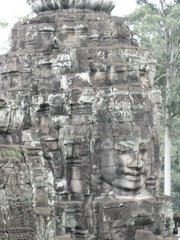Saturday, August 12, 2006
Bayon
The Bayon was built in the 13th century as the state temple of king Jayavarman VII, and stands at the centre of his capital, Angkor Thom. Its most distinctive feature is the multitude of smiling faces on the towers which rise up to its central peak. It also possesses two sets of bas-reliefs, which depict an unusual combination of mythological, historical and mundane events.

The Bayon was the last state temple to be built at Angkor, and the only one to be built primarily as a Mahayana Buddhist temple (although various local deities were also worshipped there). Under the reign of Jayavarman VIII in the mid-13th century the temple was converted to Hinduism. In later centuries Theravada Buddhism became dominant, before the temple was eventually abandoned to the jungle.

In the first part of the 20th century conservation work was led by the Ecole Française d'Extrême-Orient, which restored the temple using the anastylosis technique. Since 1995 the Japanese Government team for the Safeguarding of Angkor (the JSA) has been the main conservatory body, holding annual symposia.

I was listening to a Singaporean tour group at the corner. There were about 10 aunties and 3 uncles. It was there that I realised that Singaporean English is so distinct. We have some tones and stresses that immediately say 'Singapore'!
Bayon is my favourite temple of all. I always thought that (when I was doing my readups before the trip) it is a scary place because of the 'faces'. But I absolutely love the place. It was also the place that I start to look forward to see more temples. It was there that I realised sitting down and be part of the place is very enjoyable too.

The Bayon was the last state temple to be built at Angkor, and the only one to be built primarily as a Mahayana Buddhist temple (although various local deities were also worshipped there). Under the reign of Jayavarman VIII in the mid-13th century the temple was converted to Hinduism. In later centuries Theravada Buddhism became dominant, before the temple was eventually abandoned to the jungle.

In the first part of the 20th century conservation work was led by the Ecole Française d'Extrême-Orient, which restored the temple using the anastylosis technique. Since 1995 the Japanese Government team for the Safeguarding of Angkor (the JSA) has been the main conservatory body, holding annual symposia.

I was listening to a Singaporean tour group at the corner. There were about 10 aunties and 3 uncles. It was there that I realised that Singaporean English is so distinct. We have some tones and stresses that immediately say 'Singapore'!
Bayon is my favourite temple of all. I always thought that (when I was doing my readups before the trip) it is a scary place because of the 'faces'. But I absolutely love the place. It was also the place that I start to look forward to see more temples. It was there that I realised sitting down and be part of the place is very enjoyable too.

